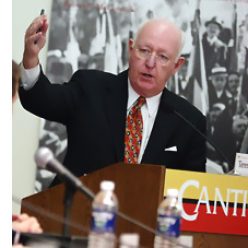An edited transcript of an interview on NPR’s Here and Now with the host, Robin Young, on January 2, 2020:
The attack on the U.S. embassy in Baghdad this week is serving as a warning about the dangers of shadow diplomacy.
The Washington Post reported this week that Rudy Giuliani was part of a back-channel effort to ease President Nicolás Maduro from power in Venezuela. President Trump’s personal lawyer was also involved in an effort to interfere in U.S. policy in Ukraine, the subject of the upcoming impeachment trial against the president.
Shadow diplomatic efforts like those orchestrated by Giuliani and others are “not new,” says former New York Times reporter Terence Smith. Smith reported on this in the late 1970s when David Rockefeller, heir to the Standard Oil fortune and chief executive of Chase Bank, tried to convince a reluctant President Jimmy Carter to bring the Shah of Iran – who was deposed in the 1979 revolution – to the U.S.
Nearly 40 years later, the Times’ David Kirkpatrick used Rockefeller’s private minutes to corroborate much of what Smith wrote in a 1981 piece about those puppet masters.
Carter’s decision to bring Shah Mohammad Reza Pahlavi of Iran to the U.S. prompted angry Iranians, who wanted the shah tried for corruption, to attack the U.S. embassy in Tehran – holding 52 hostages for 444 days.
View of a massive demonstration against the Shah of Iran in downtown Tehran, Iran, Oct. 9, 1978. (Michel Lipchitz/AP)
View of a massive demonstration against the Shah of Iran in downtown Tehran, Iran, Oct. 9, 1978. (Michel Lipchitz/AP)
After he was deposed, Mohammad Reza Shah went on an “odyssey,” Smith says, looking for a country that would accept him, his family and small band of supporters. Carter didn’t want to let the shah into the country for a number of reasons, including the fact that he wanted to establish a relationship with Iran’s new leaders.
Carter reluctantly brought the shah to the U.S. because he was told that Mohammad Reza Shah was very sick, and he could only get the treatment he needed in New York. Smith says when he asked Carter in 1981 why he admitted the shah, his answer revealed he was misinformed about the shah’s health.
“He said, ‘Well, I was told that he was close to death and that he … needed to come to New York for medical treatment and that New York was the only place where he could get this,’ ” Smith says.
“I had interviewed Dr. Benjamin Kean, who had examined the Shah and knew firsthand that that was not true,” he adds. “So I said to the president, ‘You know that’s not correct. That he was not at the point of death, and New York was not the only facility that could save him.’ In fact, the work that needed to be done could have been done anywhere, including in Mexico where he was.”
Smith says Carter “insisted vehemently” that he was told this narrative. “And I don’t doubt him for a minute,” he says.
Kirkpatrick’s latest reporting in the Times shows that Carter was in fact misled. But Carter was perhaps oblivious as to who was pulling the strings behind the scenes.
Picture of exiled Muslim leader Ayatollah Khomeini overshadows huge anti-Shah demonstration commemorating 25 years of the monarch’s rule and symbol of his power, Dec. 10, 1978, in Tehran. (Michel Lipchitz/AP)
Picture of exiled Muslim leader Ayatollah Khomeini overshadows huge anti-Shah demonstration commemorating 25 years of the monarch’s rule and symbol of his power, Dec. 10, 1978, in Tehran. (Michel Lipchitz/AP)
Rockefeller, a Republican, and his supporters were working very closely with the presidential campaign of Ronald Reagan – Carter’s opponent in the 1980 election – to ensure the hostages weren’t released until after the election. If they had been set free beforehand, Carter might have won reelection.
“David Rockefeller was a great friend and supporter of the Shah of Iran, along with Henry Kissinger and [former shah attorney] John J. McCloy, and so they had … their own agenda, as you say, their own foreign policy, if you like, which was to persuade President Carter to admit the shah,” Smith says. “And so they mounted quite a campaign to do it.”
Rockefeller was such a staunch supporter of Mohammad Reza Shah because his bank was very profitable with Iran when the shah was in power, Smith says.
“In fact, by 1979, the bank had syndicated more than $1.7 billion in loans for Iranian public projects. And that’s the equivalent of maybe $5.8 [billion] to $6 billion today,” he says. “So as they say in Washington, there was real money involved.”
The attack on the U.S. embassy in Baghdad by an Iran-backed militia is almost a repeat of history, Smith says.
“The outbreak of violence in the U.S. embassy in Baghdad in the last couple of days is so haunting because it’s almost a carbon copy of what happened in Tehran, actually nine months before the hostages were taken, and then again, when the hostages were taken,” he says.
Smith says the difference between what happened in the ‘70s and the shadow diplomacy of today is that Giuliani’s tactics are “much more direct.”
“This is the president’s personal lawyer … Rudy Giuliani taking an active role to try to bring about events that would, he hoped, help President Trump in his reelection and damage his presumed opponent, Joe Biden,” Smith says. “So this, I would argue today, is a much more blatant and out front obvious manipulation by, in this case, the president’s personal lawyer, than what you had before [which] was positively subtle and gentlemanly by comparison.”
Cassady Rosenblum produced and edited this interview for broadcast with Tinku Ray. Samantha Raphelson adapted it for the web.
This segment aired on January 2, 2020.
